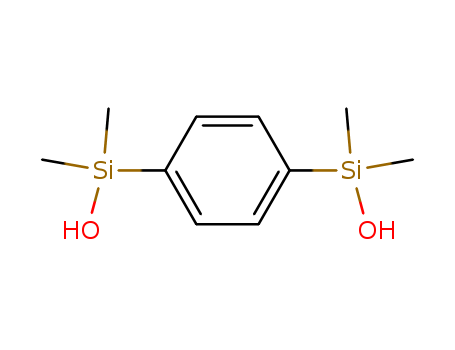- Chemical Name:1,4-Bis(hydroxydimethylsilyl)benzene
- CAS No.:2754-32-7
- Molecular Formula:C10H18O2Si2
- Molecular Weight:226.423
- Hs Code.:2931900090
- European Community (EC) Number:220-405-8
- NSC Number:83943
- UNII:2H886KS3J3
- DSSTox Substance ID:DTXSID1062625
- Nikkaji Number:J299.215I
- Wikidata:Q72445898
- Mol file:2754-32-7.mol
Synonyms:2754-32-7;1,4-Bis(hydroxydimethylsilyl)benzene;1,4-Phenylenebis(dimethylsilanol);p-Phenylenebis(dimethylsilanol);1,4-Bis(dimethylhydroxysilyl)benzene;hydroxy-[4-[hydroxy(dimethyl)silyl]phenyl]-dimethylsilane;p-Bis(dimethylhydroxysilyl)benzene;Silanol, 1,4-phenylenebis[dimethyl-;C10H18O2Si2;1,4 bis(dimethylhydroxysilyl)benzene;Silanol, 1,4-phenylenebis(dimethyl-;1,4-bis(hydroxydimethylsilyl) benzene;Silanol, p-phenylenebis(dimethyl-;Silanol, p-phenylenebis[dimethyl-;2H886KS3J3;EINECS 220-405-8;Silanol, 1,1'-(1,4-phenylene)bis(1,1-dimethyl-;Silanol, 1,1'-(1,4-phenylene)bis[1,1-dimethyl-;MFCD00039516;NSC 83943;NSC-83943;1,4-Bis(hydroxydimethylsilyl)benzene, 95%;[4-(hydroxydimethylsilyl)phenyl]dimethylsilanol;P-phenylenebis[dimethylsilanol];NSC83943;NCIOpen2_004542;SCHEMBL235602;UNII-2H886KS3J3;DTXSID1062625;Silanol,4-phenylenebis[dimethyl-;C10-H18-O2-Si2;AMY28792;2-Benzothiazolamine, 5,7-difluoro-;1,4-bis(dimethylhydroxysilyl)-benzene;1,4-Bis-(hydroxydimethylsilyl)benzene;AKOS015901503;AS-2195;SY249094;CS-0320567;FT-0705390;S01740;1,1'-(1,4-Phenylene)bis[1,1-dimethylsilanol];A819112




